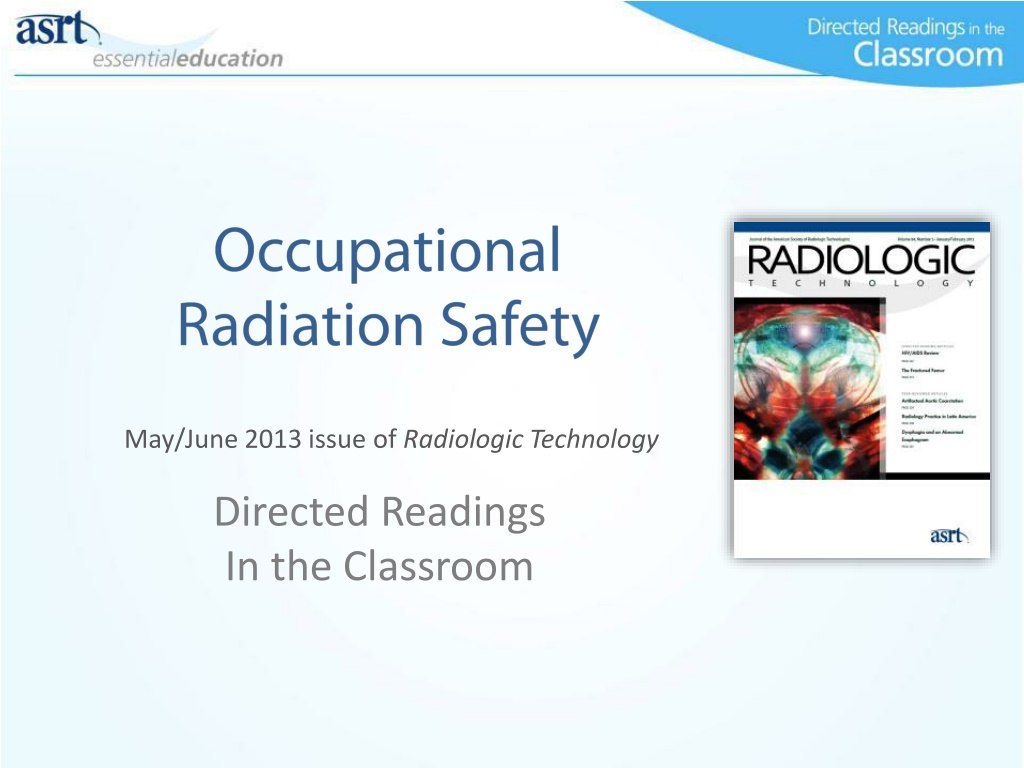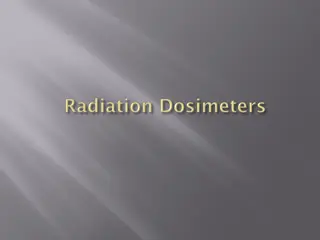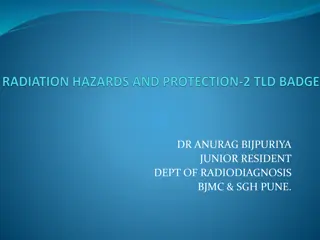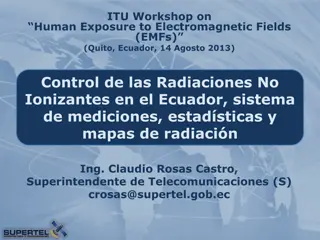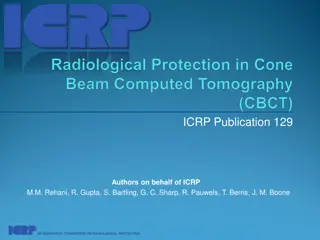Understanding Ionizing Radiation in Medical Imaging
Radiation in medical imaging plays a critical role in diagnosis and treatment but also poses risks to patients and healthcare workers. Ionizing radiation, used in various imaging modalities, can cause harm to healthy cells if not managed properly. This article discusses the implications of radiation exposure, emphasizing the importance of safety measures for both patients and professionals, particularly pregnant technologists. Awareness of the potential health risks associated with ionizing radiation is essential for all medical imaging personnel.
Download Presentation

Please find below an Image/Link to download the presentation.
The content on the website is provided AS IS for your information and personal use only. It may not be sold, licensed, or shared on other websites without obtaining consent from the author. Download presentation by click this link. If you encounter any issues during the download, it is possible that the publisher has removed the file from their server.
E N D
Presentation Transcript
May/June 2013 issue of Radiologic Technology Directed Readings In the Classroom
Instructions: This presentation provides a framework for educators and students to use Directed Reading content published in Radiologic Technology. This information should be modified to: 1. Meet the educational level of the audience. 2. Highlight the points in an instructor s discussion or presentation. The images are provided to enhance the learning experience and should not be reproduced for other purposes.
Introduction Radiation has the power to both save and harm lives. Radiologic technologists use radiation to provide quality medical imaging, but they must be aware of potential exposure to radiation s detrimental effects. When proper time, distance, and shielding techniques are used, dangerous exposure levels can be avoided. Protection techniques are even more important for a pregnant radiologic technologist, who must safeguard her fetus from exposure. With an employer s cooperation and appropriate protection in place, a pregnant technologist should be able to work in a radiology setting without harming her fetus.
Ionizing Radiation The use of medical imaging is rising, and approximately 3.3 billion of the 5 billion imaging examinations performed worldwide use ionizing radiation. Thus, diagnostic imaging contributes to the majority of artificial radiation exposure to humans. Several medical imaging disciplines and specialties use ionizing radiation, including general diagnostic radiology, nuclear medicine, computed tomography (CT), fluoroscopy, and interventional radiology. In addition, specialties outside radiology such as urology, orthopedic surgery, gastroenterology, vascular surgery, and anesthesiology often use imaging examinations involving ionizing radiation.
Ionizing Radiation Although many patients benefit from radiation s ability to destroy cancer cells or capture real-time images of the human body, radiation can harm healthy cells wherever it enters the body. It is well documented that ionizing radiation can cause damage ranging from uncontrollable cell replication to cell death.
Ionizing Radiation Studies have shown that interventional radiology workers are more susceptible to cataracts than control populations who do not work with radiation.A pregnant radiologic technologist or radiologist assistant also can put her fetus at risk if it is exposed to excessive amounts of radiation.For these reasons, all medical imaging technologists and radiation therapists need to be aware of radiation s potential to damage their own health. This is particularly important for radiologic technologists and radiologist assistants who work in fluoroscopy suites where medical personnel stand close to the x-ray source.
How Radiation Affects Cells Radiation is defined by the Radiation Effects Research Foundation as a small particle with kinetic energy that is radiated or transmitted through space.These subatomic particles also are known as photons and they encompass the spectrum of particles that have no mass and travel at 186 000 miles per second, the speed of light. The length-based spectrum of radiation waves ranges from longer, low-energy waves, like microwaves, to midrange infrared, visible, and ultraviolet light waves, up to shorter, faster x-rays and gamma rays.X-ray and gamma waves have the highest energy, and thus can pass through the human body.When these waves of energy enter a cell, their wavelengths may collide with the electrons of the cells atoms, possibly resulting in damage to the cell.
Ionization of an Atom The smallest component of all elements is the atom. A stable atom consists of negatively-charged electrons that orbit a nucleus containing counterbalancing, positively-charged protons and uncharged neutrons. When an x-ray s wavelength of energy collides with an atom s electron, the electron may be bumped out of its orbit leaving the atom with an unbalanced charge and in an unsteady state. In this state, the atom is called a radical. This process is called ionization. Unstable radicals seek a reaction to stabilize them, making them highly chemically reactive. The radicals react with and alter the chemical bonds within a cell, particularly interrupting bonds within DNA molecules and those between water molecules hydrogen and oxygen atoms.Once water molecules are ionized, they too can damage other cells.
DNA Damage Chromosomes in cells are made up of many strands of DNA that are twisted, forming a double helix. A single strand of DNA consists of 2 sugar-phosphate molecular backbones that are loosely bonded by complementary nitrogenous bases. In DNA, there are 2 complementary nitrogenous base pairs: adenine, which bonds with thymine, and cytosine, which bonds with guanine.In all, there are about 3 billion base pairs and 30 000 genes in the human genome.
DNA Damage DNA molecules are susceptible to both direct and indirect radiation damage.Direct damage occurs when the radiation energy directly breaks DNA bonds; indirect damage occurs when radiation- generated radicals break DNA bonds.Direct damage is mainly caused by high linear energy transfer (LET) radiation like alpha and neutron particles; indirect damage is mainly caused by low-LET radiation like x-rays and gamma rays.High-LET damage is more lethal to cells than low-LET damage.Cells are most susceptible to radiation-induced damage after they have replicated their chromosomes, or while they are separating the replicated chromosomes in the process of cell division.A cell normally repairs damage to its DNA, but occasionally the repair process is flawed and this can lead to a change in genetic material called a mutation.
Mutations Mutations to DNA come in different forms that may result in multiple negative consequences, such as cytoxic effects, uncontrolled cell growth, or even cell death.
Radiation-associated Cataracts While cancer likely is the most dreaded disease caused by radiation exposure, other radiation-related effects are possible. Two separate studies published in 2010 reported that interventional cardiology personnel have an increased relative risk of developing cataracts, a clouding or opacity of the eye that hinders vision.Vano et al tested 116 exposed interventional cardiologists, nurses, and technologists for radiation cataracts and compared them to 93 unexposed control personnel. Thirty-eight percent of the cardiologists, with a cumulative median lens dose of 6.0 Sv, developed cataracts, compared with 12% of the controls. Twenty- one percent of the other medical personnel, who were exposed to a cumulative median lens dose of 1.5 Sv, developed radiation- associated lens changes attributed to ionizing radiation exposure.
Radiation-associated Cataracts Similarly, Ciraj-Bjelac et al compared the eyes of 56 interventional cardiologists and 11 nurses to age- and sex- matched unexposed controls (n = 22).They found that 52% (confidence interval [CI] 35-73) of the cardiologists and 45% (CI: 15-100) of the nurses developed posterior lens opacities, compared with 9% (CI: 1-33) of the controls. The researchers concluded that, without proper eye protection, these health care professionals were at a higher risk of developing cataracts. Based on this data, in 2011 the International Commission on Radiological Protection (ICRP) reduced the lens threshold value of absorbed dose for cataracts from 5.0 Gy to 0.50 Gy.
Radiologic Technologists Exposure Some of the factors affecting the exposure risks of radiologic technologists and radiologist assistants include: How they use an x-ray system. Whether they use protective measures. Whether they optimize patient doses. The number of procedures they perform. Their height, which could affect how much scatter radiation reaches their eyes. Factors influencing exposure time include how long a procedure takes, whether a technologist or operator moves efficiently through a procedure or adheres to a protocol, and whether he or she is still learning the procedure.
Scatter Radiation When radiation enters a patient, not all of the photon beams are fully absorbed or pass straight through the molecules; many of the photons bounce off the tissues atoms and exit the body in different directions, creating scatter radiation. Therefore, even though a radiologic technologist is not in the path of a radiation beam, he or she is susceptible to scatter radiation that mainly emanates from a patient. Scatter, or secondary, radiation is the main source of occupational radiation exposure. Low-energy beams are absorbed more readily by a patient, producing less scatter radiation.Oblique projections increase the kilovoltage peak (kVp), resulting in an increase in scatter radiation exposure to the patient and staff, and compromised image quality.
Scatter Radiation Scatter radiation is concentrated at the table level and a beam entering a patient s thorax creates a significant amount of scatter radiation. Strategically placed lead shields are ideal for absorbing scatter radiation, such as a radiation- attenuating shield placed over a patient or a portable lead shield. Technologists also can avoid scatter radiation by creating distance between themselves and its source. Most of the time, distance and shielding techniques help protect radiologic technologists from exposure to scatter radiation.
Radiation Limits In 2007 the ICRP recommended that medical workers receive a maximum radiation effective dose of 20 mSv per year, averaged over 5 years, with no more than 50 mSv in 1 year.In addition, 500 mSv each is the annual equivalent dose radiation limit to the skin, hands, and feet. For the lens of the eye, the equivalent dose limit was initially 150 mSv, but in 2011 the ICRP reduced this to 20 mSv per year, averaged over 5 years, with no single year exceeding 50 mSv.
Radiation Limits One study investigated which body parts of an operator received the most radiation exposure. Koukorava et al used thermoluminescent dosimeters (TLD) and pellets to measure the exposure of 2 operators who performed 50 interventional radiology procedures over 6 months. The operators each used a thyroid collar, a lead apron, and a table shield as their personal radiation protection, but no protective lead glasses. The researchers speculated that lower dose to the leg was because of the proper use and position of the table shield. They recommended that special attention be given to personnel on the other side of the table who may not have a shield.
Radiation Protection The ICRP set out 3 fundamental principles for an overall system of radiation protection: justification, dose limitation, and optimization of protection. Justification refers to the necessity to do more good than harm when deciding whether radiation use is necessary. The ICRP established dose limitations for occupational radiation to manage workers exposure via proper facility design and operation planning. Within the optimization of protection principle are 3 more tenets of radiation protection: time, distance, and shielding.
Radiation Protection Radiologic technologists and radiology assistants can use the following techniques to decrease the amount of radiation they receive: Pulsed fluoroscopy. Short fluoroscopy and cine times. Minimal number of required images per series. Limited series. Optimal dose rates for an acceptable image quality. If optimal dose rates are not used, then image quality will be poor and the procedure will need to be repeated, exposing both the patient and the personnel to additional radiation. Leaded protection garments worn by a radiologic technologist or radiologist assistant absorbs radiation before it reaches the user s body. From head to toe, the following garments and accessories can provide shielding protection.
Eye Protection To reduce the risk of vision damage, eye protection is available through a variety of means to suit a user s needs: Regular leaded glasses; corrective prescriptions also are available; side shields are advisable Leaded glasses that fit over regular prescription glasses. Leaded clip-on shield that attaches to regular prescription glasses. Full-face lead shield to protect the eyes and function as a splash guard. Leaded glass or plastic screens/shields. Eye glasses made of plastic, standard glass, photochromic lenses, and lead-glass lenses reduced the amount of radiation exposure to the phantom user s eyes by 0% to 97%, depending on the x-ray tube potential. A lead-acrylic face mask reduced the brain dose by 81%.
Face Protection If the operator s eyes are exposed to radiation, the brain, nose, cheeks, and mouth also are exposed. Face masks may be used to protect the entire face of personnel who are exposed to radiation, most likely in the form of scatter radiation from patients. Face masks are normally made of acrylic that is impregnated with lead, and the head piece can be adjusted to fit the user. Manufacturers also offer antistatic spray and antifog cleaner to keep the masks clear and comfortable.
Thyroid Protection Because of the thyroid s location fairly close to the skin and likely within the trajectory of scatter radiation, it is susceptible to radiation damage that can trigger negative effects throughout the body. If this influential organ is not already protected with a neck shield attached a lead apron, then a thyroid collar should be worn. Because of the thyroid s location fairly close to the skin and likely within the trajectory of scatter radiation, it is susceptible to radiation damage that can trigger negative effects throughout the body. If this influential organ is not already protected with a neck shield attached a lead apron, then a thyroid collar should be worn.
Hand Protection Radiologic technologists and radiologist assistants hands and wrists are frequently exposed to either a direct beam of radiation or scatter radiation, so it is wise to be aware at all times of where these extremities are located in relation to the radiation beam. Radioprotective gloves could block 15% to 30% of scatter radiation, but if gloved hands are in the beam s path, a fluoroscopy machine will automatically increase the kilovolts (kV), raising the amount of radiation exposure to medical personnel and the patient; in these cases, gloves could provide a false sense of protection and negate their benefit.
Hand Protection However, it stands to reason that thicker gloves also are less accommodating for procedures that require dexterity. Flexible, leaded or lead-free gloves are an option but 1 study noted that certain types of radiation-attenuating flexible gloves are prone to produce forward-scatter and backscatter x-rays, thus reducing their protective effectiveness. Therefore, they concluded that in lieu of shielding, time and distance were the best options personnel had to protect their hands during interventional radiology and cardiology procedures.
Chest and Abdominal Protection A lead apron is a popular garment technologists use for protection. All staff in a fluoroscopy suite should wear a lead apron.It can sufficiently protect the areas it covers from radiation, but the degree of protection depends on the lead s thickness and a beam s intensity.All staff in a fluoroscopy suite should wear a lead apron.It can sufficiently protect the areas it covers from radiation, but the degree of protection depends on the lead s thickness and a beam s intensity.
Leg Protection Although technologists hands may seem closer to the radiation source during interventional procedures, their legs and feet may receive an equal or higher amount of radiation. One study showed that the mean radiation dose to operators legs was between 0.19 and 2.16 mSv per interventional procedure, while the hands received between 0.04 and 1.25 mSv.This leg exposure dropped to approximately 0.02 mSv when protection was used. The researchers determined a rule of thumb that, if no protection was used, a dose-area product (DAP) reading of 100 Gy cmwould translate to 1 mSv of radiation dose to the legs. They also suggested that a lead screen be used to protect the legs of personnel involved with interventional procedures. Alternatively, a table shield could be constructed from used lead aprons.
Protective Pads A drape over or under a patient also can be helpful to reduce scatter radiation. One such drape is the RADPAD, a lead-free, disposable bismuth antimony shielding pad. This pad may be disposed of in the regular trash because it does not contain lead or vinyl. Although the RADPAD now is made with bismuth, it is still safe for regular disposal and the drapes come in a variety of procedure- specific designs.
Ceiling Suspended or Mounted Shielding Screens Leaded shields can either be acrylic or glass panels that can be suspended from the ceiling or portable on wheels. These shields absorb up to 90% of the scatter radiation with the equivalent of 0.50 mm of lead within their plastic or glass.Because of their effective absorbency, especially in protecting the eyes, shields should be used in all fluoroscopy suites, even though they may seem like a hindrance at times. Thornton et al found that a ceiling-suspended shield eliminated all detectable radiation at the eye level of a phantom operator during digital subtraction angiography, besting the protection provided by lead glasses and scatter radiation-shielding drapes used either alone or together.
ZeroGravity Radiation Protection System Recently, a physician invented a protection system called the ZeroGravity Radiation Protection System. To eliminate the heavy weight of traditional protection devices like aprons, collars, and glasses, this entire system is suspended from the ceiling and protects the operator from head to leg. The system s pivoting arm allows it to shadow the user as he or she moves about unimpeded. The ZeroGravity system comprises a lead apron that is thicker than a 0.50 mm apron and a wraparound face shield that protects the entire face and thyroid.
The Inverse Square Law The physics of radiation helps protect radiologic technologists from unwanted exposure. Photons used in the clinical setting lack the ability to maintain their energy over a great distance after emittance from their source. Delfino and Day described how radiation s energy declines, saying, Radiation dissipates inversely as the distance from the source is squared tissue twice as far away from the radioactive seed receives the dose. This is known as the inverse square law.
Positioning Because of the inverse square law, moving away from the source of scatter radiation helps reduce radiation exposure. If a technologist moves just inches back, he or she benefits from the photon s inability to maintain its high energy. One study detected virtually no radiation 5 meters away from a biplane angiography unit s x-ray tube used for Because of the inverse square law, moving away from the source of scatter radiation (mainly the patient) helps reduce radiation exposure. If a technologist moves just inches back, he or she benefits from the photon s inability to maintain its high energy. One study detected virtually no radiation 5 meters away from a biplane angiography unit s x-ray tube used for endovascular surgical neuroradiology.When such a distance is not feasible, at least some distance from the patient still can be beneficial.
Equipment An under-couch x-ray tube, as opposed to an over-couch position, ensures that scatter radiation will occur when the primary beam enters a patient.It is important to be aware that, even when an under-couch set-up is used, an operator standing on the x-ray tube side of the table still receives 10 times more radiation exposure than if he or she stood on the image receptor side.The ideal scenario for minimizing a radiologic technologist s scatter radiation exposure is to stand on the image receptor side of the table, opposite the tableside with an under-couch x-ray tube. Collimation, the narrowing of an x-ray beam to target only the area of interest, is another technique that can reduce scatter radiation and improve image quality.Some fluoroscopy units can perform virtual collimation, positioning the collimators without radiation.
Power Injectors Interventional radiologists receive the bulk of their radiation exposure while manually injecting contrast media during digital subtraction angiography (DSA).One study by Layton et al found that endovascular surgical neuroradiologists who regularly perform hand injections received more than 75% of their radiation dose from DSA procedures, while another study by Hayashi et al found that the injection portion of the DSA procedure accounted for more than 90% of the total radiation exposure to the operator.Both studies acknowledged that power injectors allowed medical personnel to move away from the radiation source and reduce their exposure; however, Layton et al noted a tradeoff between a power injector s slower procedural time vs its increased radiation protection.
Radiation Monitoring Personal monitoring is strongly encouraged for all staff who work in controlled areas where radiation exposure can occur. If a radiologic technologist or radiologist assistant finds that his or her radiation dose is too high, adjustments can be made to reduce exposure and safeguard health. If individual, personal monitoring is not feasible, radiation exposure should be measured with a passive or electronic workplace monitor, such as a dosimeter placed on the C-arm of a fluoroscopy unit.
Dosimeter Badge Dosimeters are used to measure radiation exposure from gamma rays and x-rays. Because a dosimeter badge worn outside the apron would not reflect the radiation absorbed by the apron s lead, an individual monitor should be worn under the apron at the chest level, between the shoulders and waist.Badges worn on the collar can be used to estimate thyroid and lens doses. There are 2 types of personal dosimeter badges: passive and active. Passive badges can be checked after a period of time. Active badges measure radiation dose in real-time, giving radiology personnel immediate feedback regarding their exposure.
Dosimeter Badge A passive monitor s exposure level should be checked monthly, with no more than 3 months between checks.If too much time passes between dosimeter readings, the stored information may be lost. If a radiologic technologist loses his or her badge, dose can be estimated using recent dose history or badge readings of A passive monitor s exposure level should be checked monthly, with no more than 3 months between checks.
Dosimeter Badge If too much time passes between dosimeter readings, the stored information may be lost. If a radiologic technologist loses his or her badge, dose can be estimated using recent dose history or badge readings of fellow technologists, or with a workplace dosimeter. It is important to use calibrated dosimeters that are tested in a laboratory approved by a regulatory agency.Annual calibration is recommended, but it is best to check a dosimeter manufacturer s manual to determine the required frequency of calibration.Some dosimeters conduct internal, self-test calibration procedures, but even these may need confirmation of accuracy with external tests. One test involves exposing the dosimeter to 2 sources of photons, such as cesium 137 and americium 241.
Finger Dosimeter Technologists hands can potentially receive a high dose of radiation, particularly during procedures when they are working near the source of an x-ray or gamma ray beam. A ring dosimeter reflects the amount of radiation exposure the hands receive.
Radiation and the Pregnant Radiologic Technologist Radiation protection is important for all radiologic technologists, but it takes on a new meaning when a technologist becomes pregnant. It is incumbent upon the pregnant technologist, radiologist assistant, or any expectant medical worker who may be exposed to radiation to protect herself and her fetus during pregnancy. Because of its power to mutate DNA or cause cell death, radiation can trigger an array of ailments in an unborn child. Studies have shown that this occurs at levels of radiation exposure that are typically not reached when proper occupational protection is in place to abate occupational radiation.
Declaration of Pregnancy When a radiologic technologist confirms that she is pregnant, the first step in protecting herself and her fetus is to declare her pregnancy to her employer.In the eyes of some institutions, the institution is not liable for proper precautions to protect a pregnant worker from radiation unless she has officially acknowledged her pregnancy.Once a declaration has been filed, the fetus is treated like a member of the general population.
Fetal Dose Limits The National Council on Radiation Protection and Measurements (NCRP) recommends an occupational radiation fetal dose limit of 5.0 mSv during an entire pregnancy (with a daily limit of 0.025 mSv), and less than 0.5 mSv per month.The ICRP recommends less than 1.0 mSv total fetal exposure during an entire pregnancy. In general, these limits are achievable with the proper precautions in place.
Employer Obligations In an ideal situation, a radiologic technologist s declaration of pregnancy should trigger the following actions by her employer. Careful evaluation of the woman s environment to determine whether there are any risks of radiation exposure that could exceed the limit of exposure to her fetus. A full explanation provided to the pregnant employee about the potential risks of fetal radiation exposure, local policies, and dose limits. A review of what methods and extra protection the woman can use to reduce her exposure.
Radiation Doses and Their Consequences The most precarious time for a fetus to suffer the negative effects of radiation are weeks 8 through 15 of gestation, when its organs and nervous system are forming.Severe issues have a higher probability of occurring after 1.0 to 2.0 Sv of radiation exposure, but research has shown that defects can occur at levels of 100 to 200 mSv. The risk of developing childhood cancer is highest if a fetus is exposed to 200 to 250 mSv between weeks 2 through 15 of gestation, while more than 100 mSv of radiation can increase the frequency of childhood cancer and cause small head size, seizures, and reduced IQ. The risk of developing childhood cancer is highest if a fetus is exposed to 200 to 250 mSv between weeks 2 through 15 of gestation, while more than 100 mSv of radiation can increase the frequency of childhood cancer and cause small head size, seizures, and reduced IQ.
Reducing Radiation Exposure to a Fetus Pregnant technologists can employ the radiation protection principles of time, distance, and shielding to reduce their exposure to radiation, and consequently that of their fetus. Wearing 2 protective lead aprons or a maternity bib can provide extra layers of protection.Some researchers also suggest that, because of the possibility that a learning curve will extend exposure time, a pregnant woman may want to postpone learning new radiologic techniques until after she gives birth.Angling the fluoroscopic tube in a posteroanterior or right anterior oblique projection reduces exposure during a catheterization procedure.As mentioned previously, the use of a power injector is advised to lower radiation exposure, as is reducing frame rates, which decreases one s exposure by 40% to 60%.When feasible, using a lead shield can block the majority of scatter radiation.
Fetal Dose Monitoring To determine how much radiation her fetus has received, it is imperative for a pregnant radiologic technologist or radiologist assistant to wear a monitor under her lead apron at her waistline. Passive monitors give the dose reading at the end of the day or month, while active monitors measure in real-time and sound an alarm if the exposure limit is exceeded. An active monitor may provide more peace of mind because a woman will know whether she is receiving too much radiation and immediately adjust her position to reduce it.
